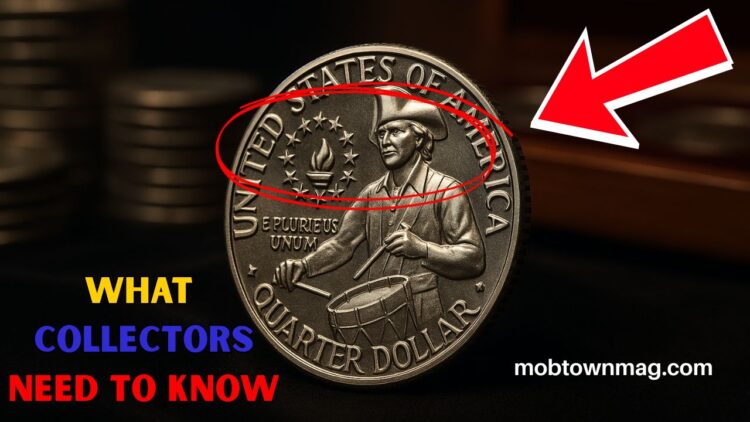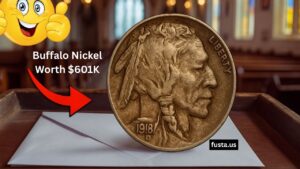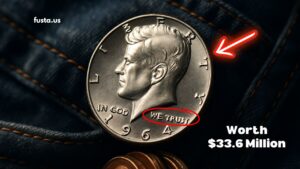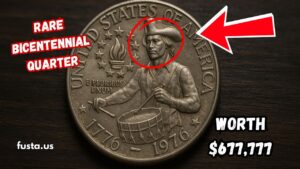Have you ever thought that the coins in your wallet might be worth a fortune? Most of us treat coins as just small change, but some rare ones can make people millionaires. One such coin is the 1976 Bicentennial Quarter, created to celebrate America’s 200th year of independence.
While many of these coins are worth just 25 cents, rare versions have shocked the world with values running into millions of dollars, and in some cases, even up to $2.5 billion. This guide will explain what the Bicentennial Quarter is, why some are so valuable, how to identify one, and where you can find them.
What Is the Bicentennial Quarter?
The Bicentennial Quarter was released in 1975 and 1976 to mark the 200th anniversary of U.S. independence.
- Obverse (Front): Features George Washington’s portrait (like regular quarters).
- Reverse (Back): Shows a colonial drummer with a victory torch surrounded by 13 stars representing the original colonies.
Most of these coins are common circulation coins, but rare types exist that make them extremely valuable.
Why Is the Bicentennial Quarter Valuable?
Most Bicentennial Quarters are worth just their face value of 25 cents, but some became rare because of:
- Minting Errors – such as double-stamped designs or missing letters.
- Special Metal Blanks – some were struck on silver or experimental alloys instead of regular copper-nickel.
- Limited Mint Marks – certain coins from San Francisco (S) or with no mint mark are highly sought after.
Collectors prize these coins because they are rare, unique, and tied to a historic event.
How to Identify a Rare Bicentennial Quarter
Here are the key things to check:
1. Date and Mint Mark
- Look for 1776-1976 on the back.
- D (Denver) & P (Philadelphia): Common, but some errors exist.
- S (San Francisco): Usually silver, especially in proof sets.
- No mint mark: Very rare and valuable.
2. Minting Errors
- Double Die – text or drummer image looks doubled.
- Wrong Metal – struck on silver or copper blanks.
- Missing Details – letters, stars, or numbers not printed fully.
3. Material
- Normal: Copper-nickel.
- Rare: 40% silver or special alloys.
4. Condition
Coins in uncirculated or mint condition fetch higher prices. Never polish or clean a coin as it reduces its value.
Where Can You Find Them?
You don’t have to be a professional treasure hunter. These coins can turn up in:
- Everyday change – check wallets, cash registers, and piggy banks.
- Coin rolls from banks – sometimes rare coins are mixed in.
- Garage sales or flea markets – hidden in old collections.
- Family collections – many households keep old coins unknowingly.
Value of Bicentennial Quarters
Here’s a quick breakdown of values:
| Type of Quarter | Value Range |
|---|---|
| Regular Copper-Nickel (P/D Mint) | 25 cents |
| 1976-S Silver Proof (perfect) | $10 – $50 |
| Double-Die Error | $500 – $1,000 |
| Rare Experimental Metal | Millions at auction |
| Ultra-rare versions (unique errors) | Up to $2.5 Billion |
Common vs. Rare Bicentennial Quarters
| Feature | Common Quarters | Rare Quarters |
|---|---|---|
| Material | Copper-Nickel | Silver / Alloy |
| Mint Mark | P or D | S / No Mark |
| Design | Normal | Double Die / Error |
| Value | 25 cents | $10 – Millions |
Tips for Coin Hunters
- Use a Magnifying Glass – errors are often small.
- Learn Coin Grading – terms like “proof” and “mint state” matter.
- Join Coin Clubs – online and offline communities can help.
- Store Safely – use protective sleeves or cases.
Coin Terms
| Term | Meaning |
|---|---|
| Mint Mark | Letter showing where the coin was minted. |
| Double Die | A mistake where the design is stamped twice. |
| Proof Coin | High-quality coin made for collectors. |
| Uncirculated | A coin that was never used in spending. |
| Alloy | A mix of metals used in coin making. |
The Bicentennial Quarter is not just a small piece of pocket change—it can be a life-changing treasure. By checking for mint marks, errors, silver content, or unique details, you might uncover a coin worth thousands, millions, or even up to $2.5 billion. Start searching your pocket change, bank rolls, and family collections—you never know, the next fortune could be sitting right in your pocket.
FAQs
What makes a Bicentennial Quarter rare?
A Bicentennial Quarter becomes rare if it has minting errors, is struck on silver/alloy blanks, or comes from San Francisco (S) mint.
How much is a 1976 Bicentennial Quarter worth today?
Most are worth 25 cents, but rare versions can go from $10 to millions, depending on condition and uniqueness.
Where can I sell a rare Bicentennial Quarter?
You can sell it at coin dealers, auctions, or grading services like PCGS or NGC for the best value.




